Who, in their right mind, would ever think that a strangler fig, with the ginormous leaves and the aggressive aerial roots, would (or could) make a good bonsai?
This guy ⤵

That’s who.
Plus, Erik Wigert, Jim Smith, Pedro Morales and many others.
Who doesn’t?
Well, lets just say that there are those who doubt. The naysayers and poo poo-ers.
Then there are those who have no idea what in the jungle a strangler fig is.
I’ll speak to you first, my noobies.
The common name “strangler fig” actually refers to several, unrelated ficus species.
The two I have to work on are the dwarf African strangler fig (ficus natalensis) and the native Florida strangler fig (ficus aurea)

I’m not sure why they call the f. natalensis a “dwarf” strangler fig
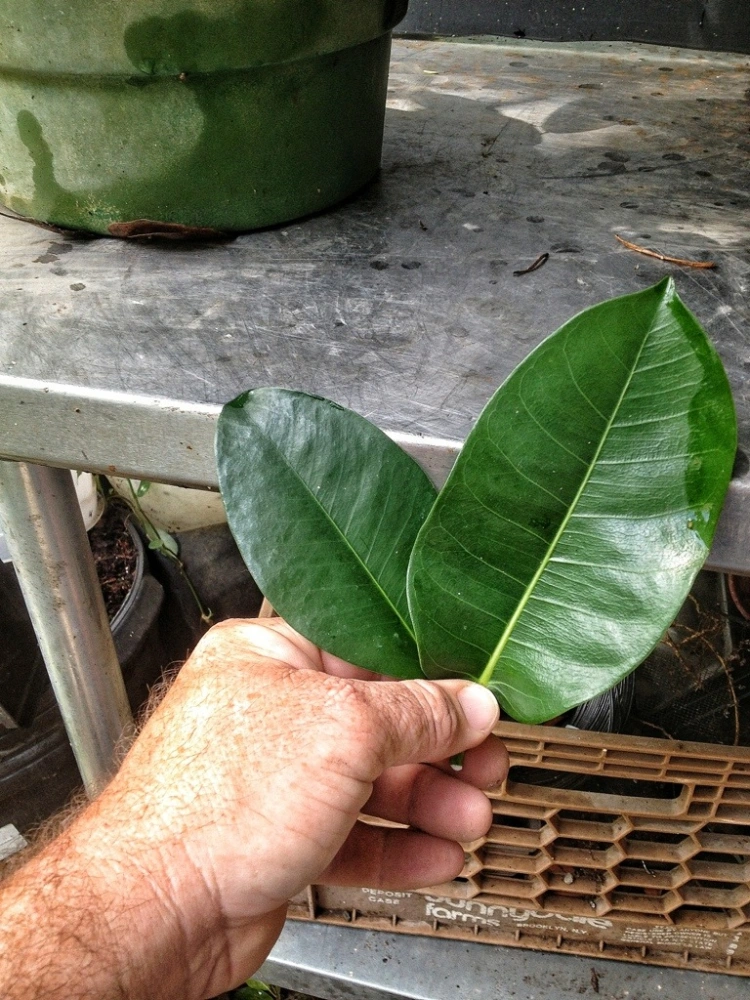
The leave is slightly smaller.
Maybe it doesn’t grow as tall?
Anyway, the one on the left is f. natelensis.
The stipules (which is a sheath-like structure that encases new leaves before the open) are different.
F. natelensis

Which, oddly, is longer than the f. aurea stipule
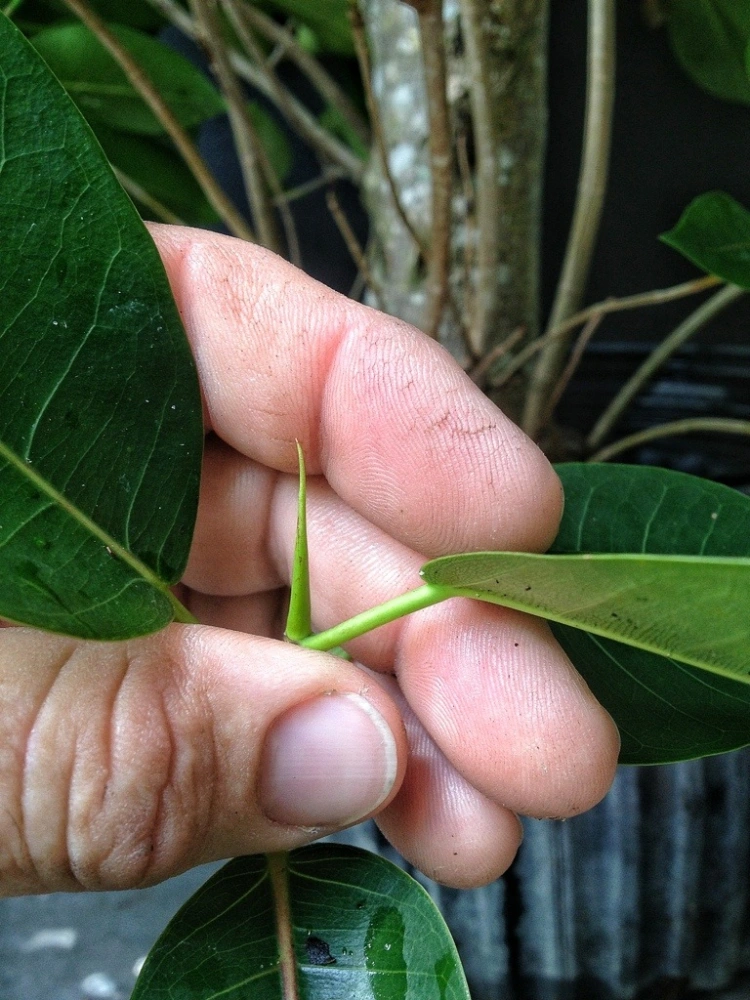
considering the latter gets bigger leaves.
The bark is different too:
F. natelensis

F. aurea

So why are they both called strangler figs?
The one aspect that makes these trees unique is their seeds ability to germinate without soil.
Let me paint a picture for you. A monkey is relaxing in a tree (there are monkeys in Florida, after hurricane Andrew, a family escaped from a zoo near Miami and naturalized themselves in the wild. The alligators love them.) munching on a fig and, after the appropriate time passing, the monkey passes, complete with undigested fig seeds.
Considering that some monkeys have bad aim when they throw their poop at tourists, these seeds sometimes find themselves deposited in nooks and crannies of trees or bushes; and even the cracks of buildings (usually Federal buildings and police stations; monkeys being naturally anarchistic). The seed will germinate and begin to grow, epiphytically, dropping down aerial roots that may take years to reach the soil. This process will eventually envelop the structure the ficus is on (tree, building).
In the case of a tree, the ficus often kills it (hence the name strangler) and the tree will rot out from the middle, leaving a hollow, columnar ficus form. Cool.
Here’s a tree from Erik Wigert’s

He collected this cypress with the ficus growing inside of it. Imagine the monkey using the hollowed out cypress for a….I’ll leave at that.

Cooler.
Back to my trees.
I got the f. aurea from Erik. He collected it in Southwest Florida somewhere.

The natalensis I got from Jim Smith.

I’ll start with it.
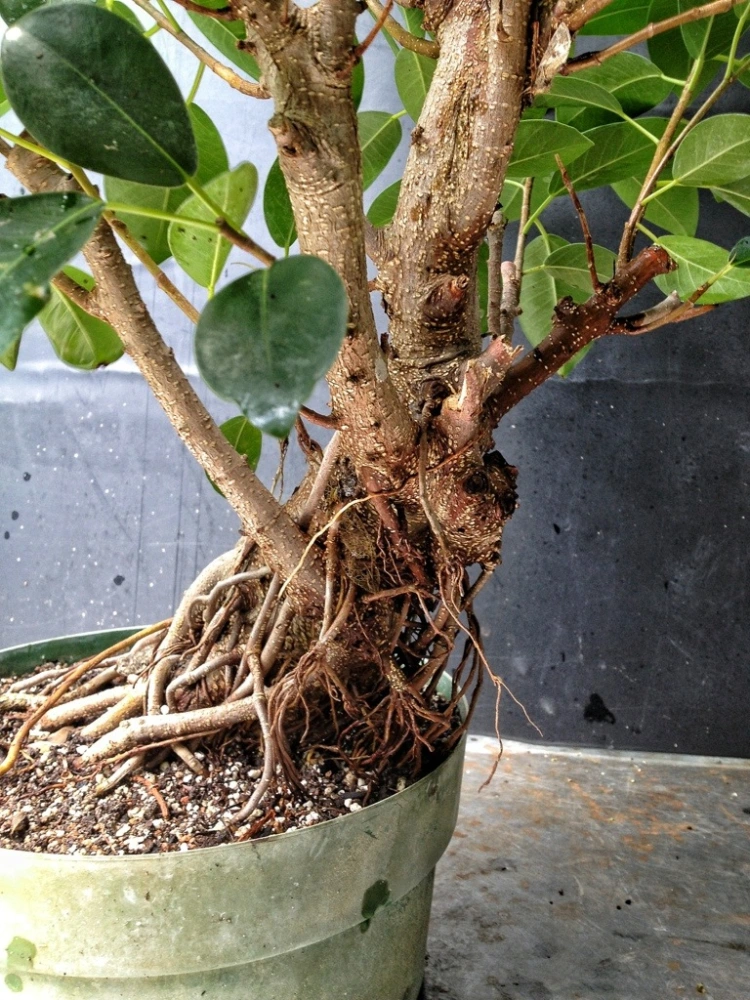
Not sure why I got it. The branches are unusable

These two come off the trunk at a weird angle

The aerial roots engulf the trunk like some weird, solid miasma.

The only thing to do is cut it back

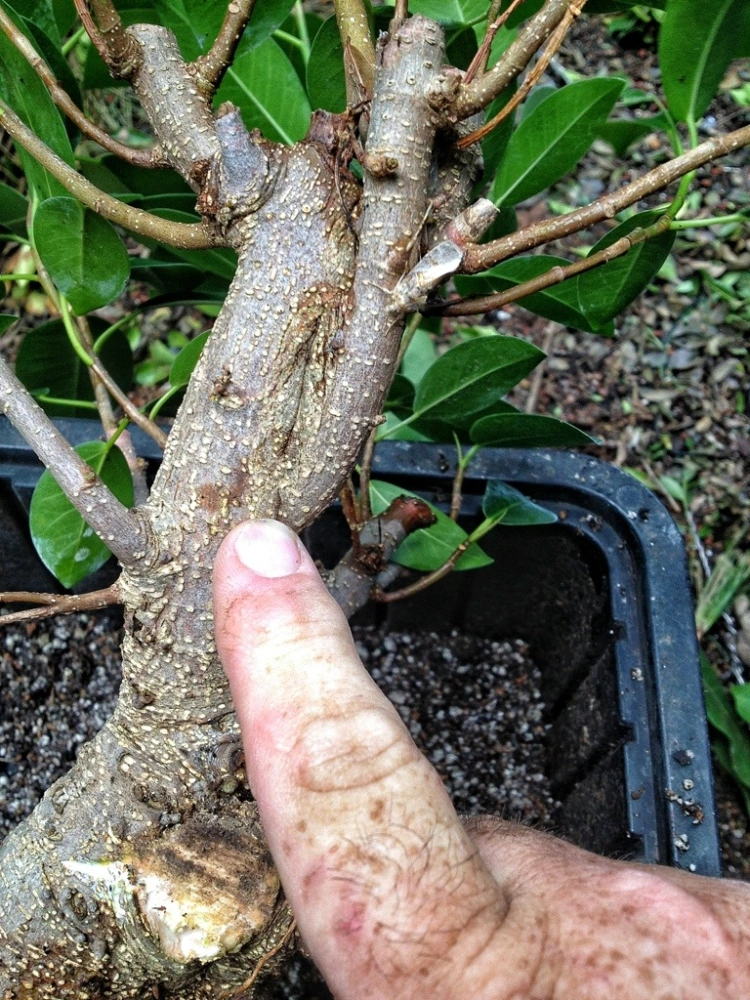

Straighten the roots

A little wire
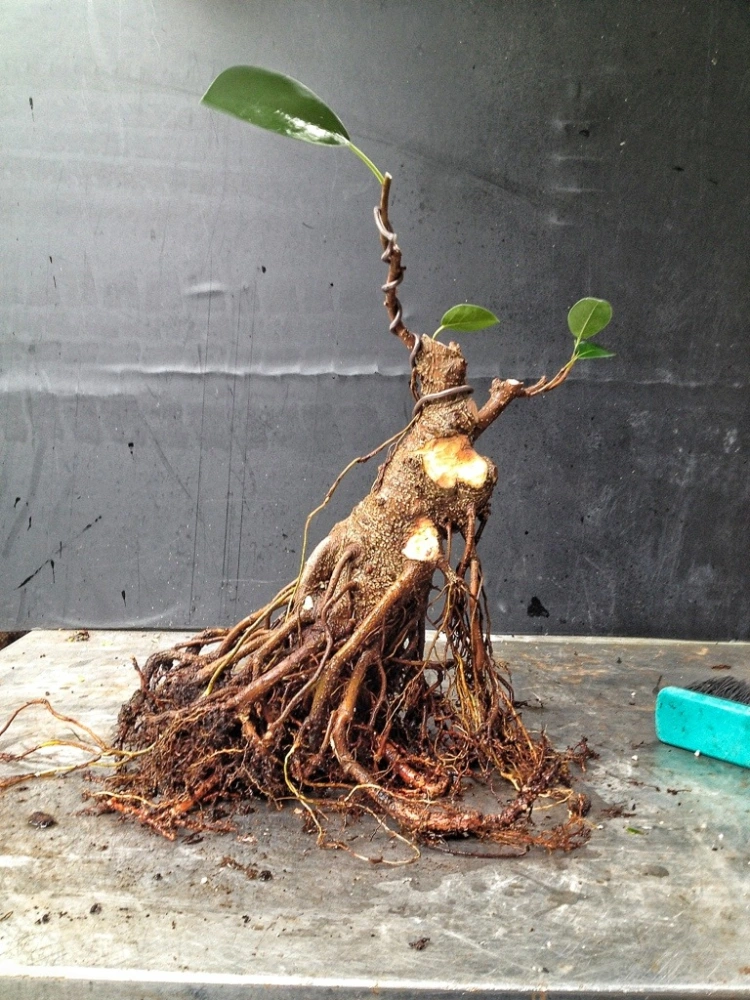
A familiar pot


There is one aerial root that is coming from close to the top

By tying it to the trunk

It should eventually fuse with the trunk, adding to the character of it.
I potted it slightly crooked

For no reason. It just happened. It’s just a training pot.
Fertilizer, full sun, let it grow, watch the wire. That’s all I can do with this one.
That was the work. I always do a little work first.
Now I get to play.
I know exactly why I picked this one

That one branch

You’ll see.
What I plan on doing hinges upon this trees ability to do this

That wound has healed almost completely. Most ficus take many many years to do that, if at all.
This wound is not that old, considering the size of the trunk. Maybe 10 years old.
At least, that’s what I’m betting on.
Let me clear out some of the superfluous wood, so you can see what I’m doing

Wup, that was abrupt.
I plan on a bunjin style tree.
With a little carving too.
To make it easier (not really, I should have used my big angle grinder) I cut a wedge
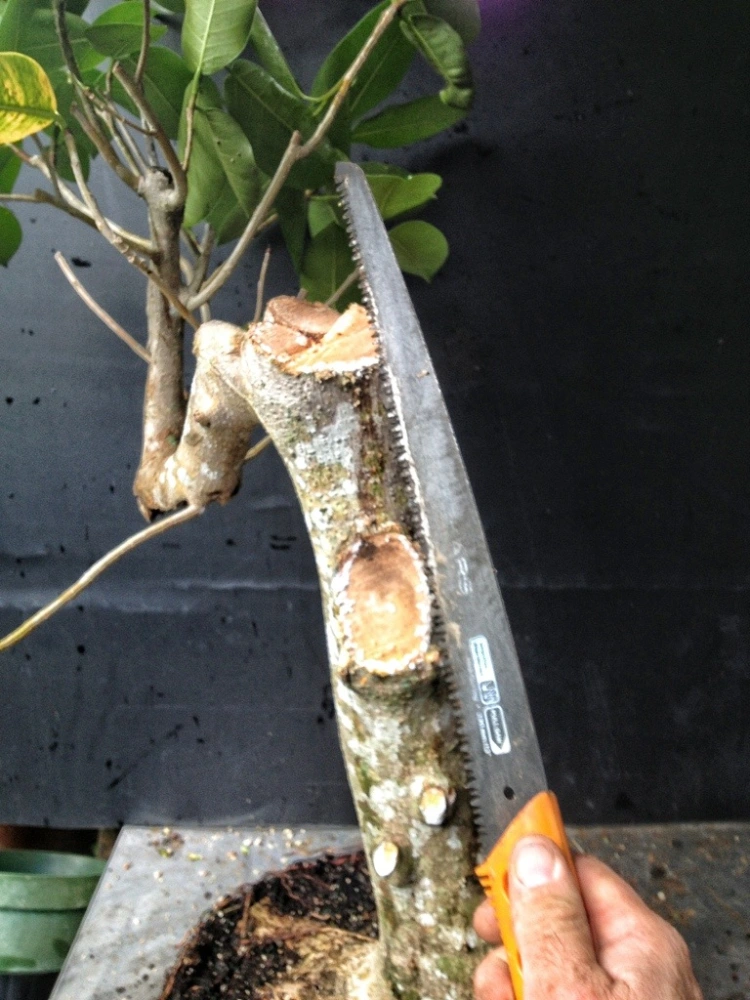

and pull out the die grinder to finish the job. The aim is to create some taper by carving a hollow. And, when it begins to roll over, it will look incredibly old.

Some fire and then the knife

And that doesn’t look too bad

Everything else is covered in sawdust.
Including me

Such is my life

I wouldn’t have it any other way.
Next, it’s branch selection.
The hardest part on any bunjin tree

It’s a matter of the “less is more” principle.

This will be the top of the tree.
I don’t want to compromise that wound. (He says this after brutalizing the trunk, who is this guy?)
A quick defoliation

And this is what I left.
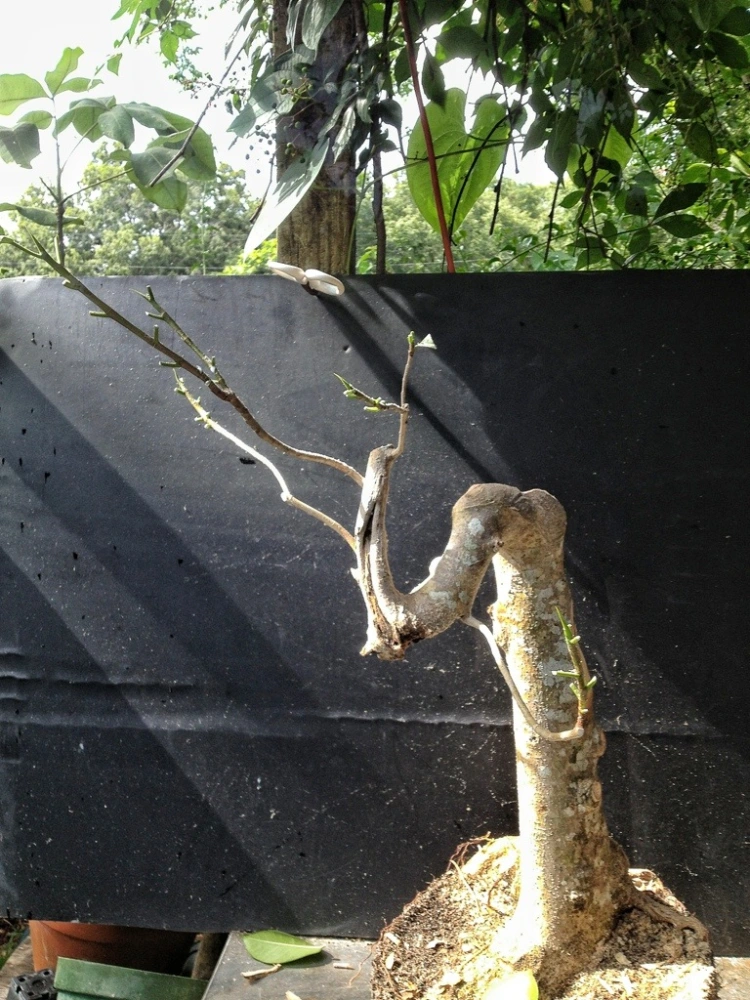
Some wire
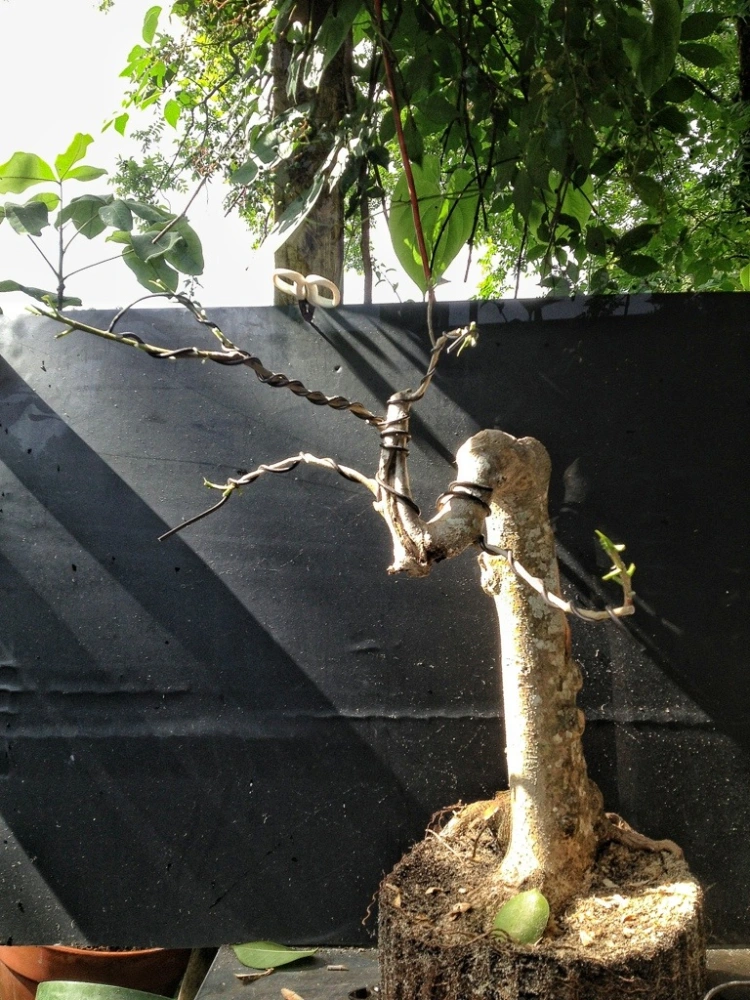
Some bending

And now to repot (you’ll have to wait until the end to see the, uh, end).
I found this fine designer, plastic pot in the pile.
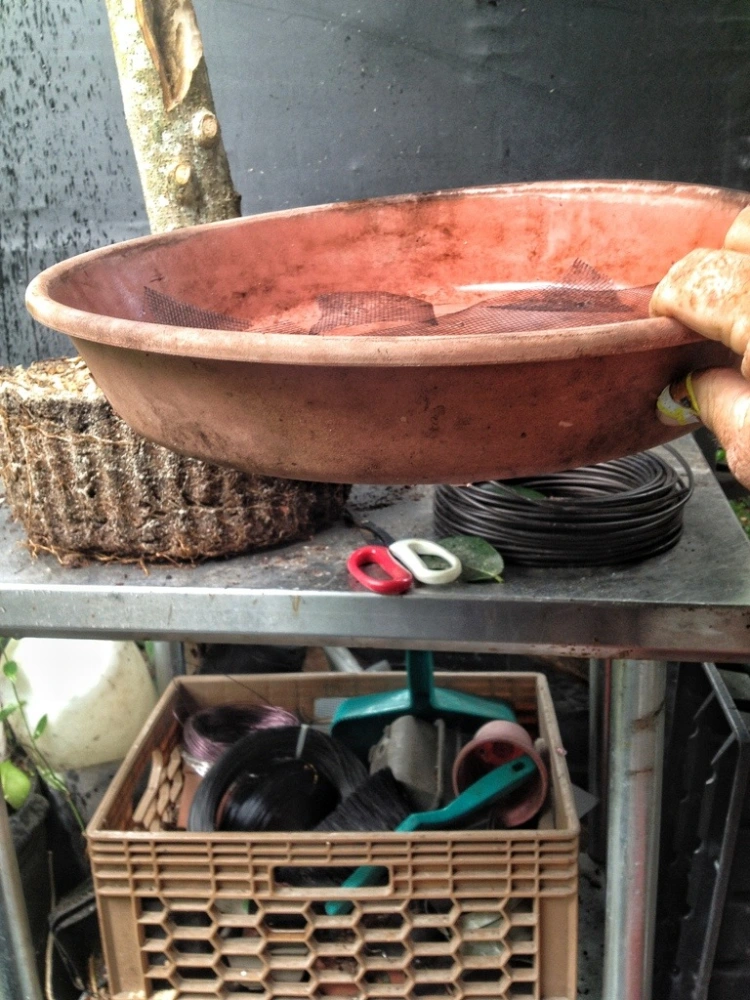
It’ll have to do.
It needs some clean up on top

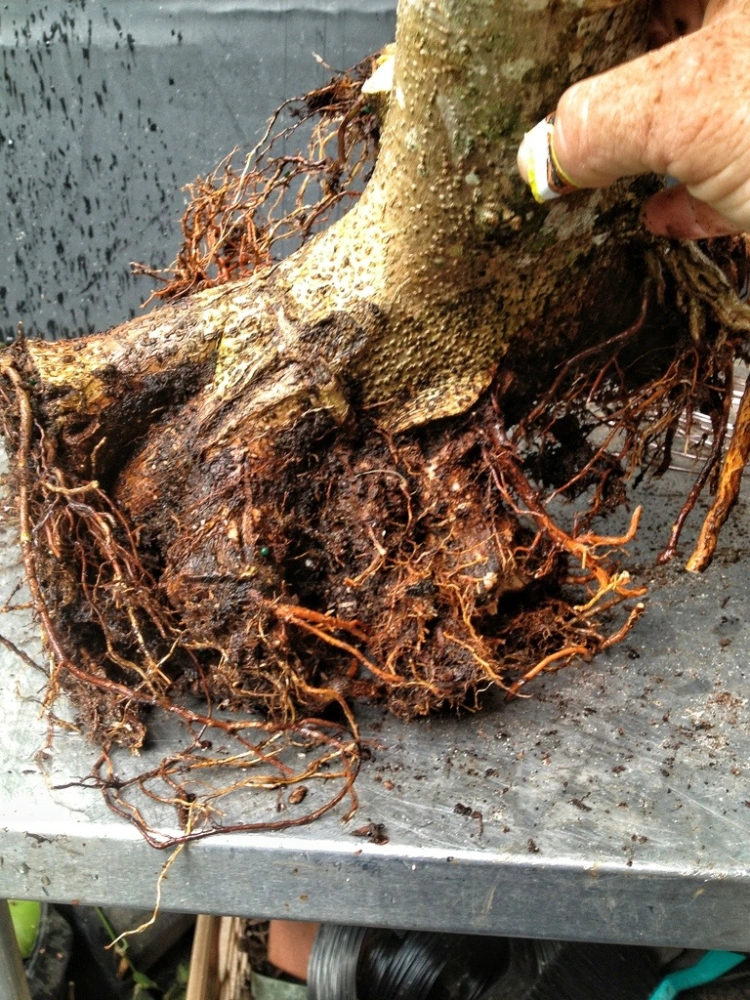
Especially at the cut ends

To ensure a smooth transition into the soil I will need to cut the corners (so to speak)

which should heal over and appear to be two roots.
And next I need to plate cut the bottom

Why would such an extreme procedure be necessary here?
To induce more rooting. Right now the only roots are coming from just those cut ends.
By plating

roots should emerge from near that cut edge
(Here, highlighted in red)
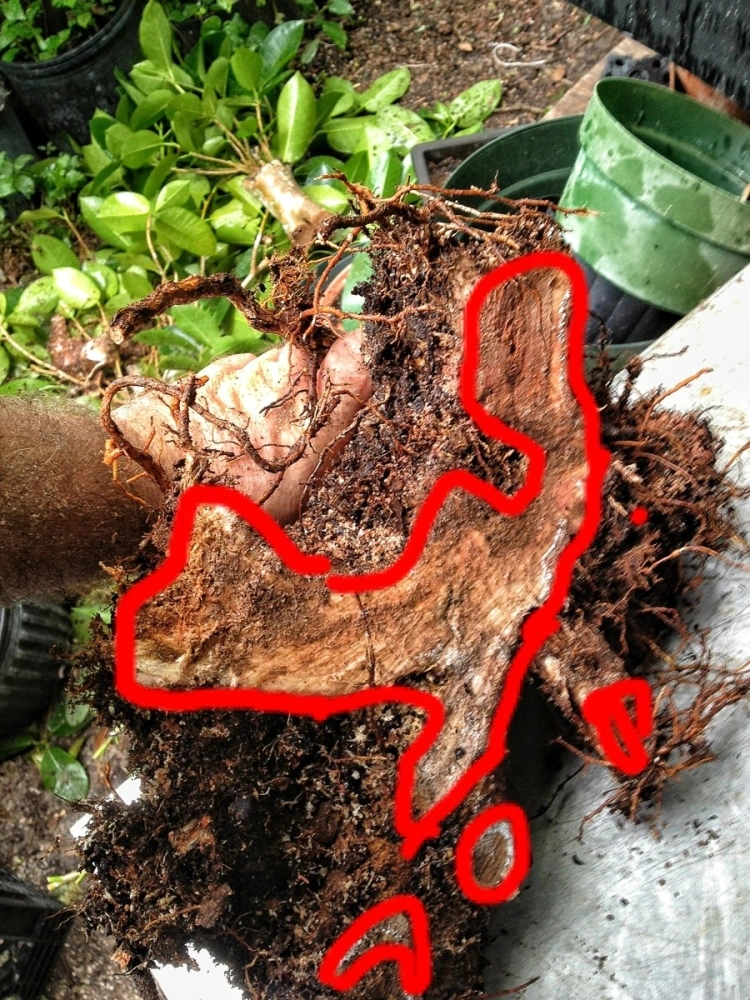
Which will improve the nebari considerably.
Next is the potting

And now you get to see the tree
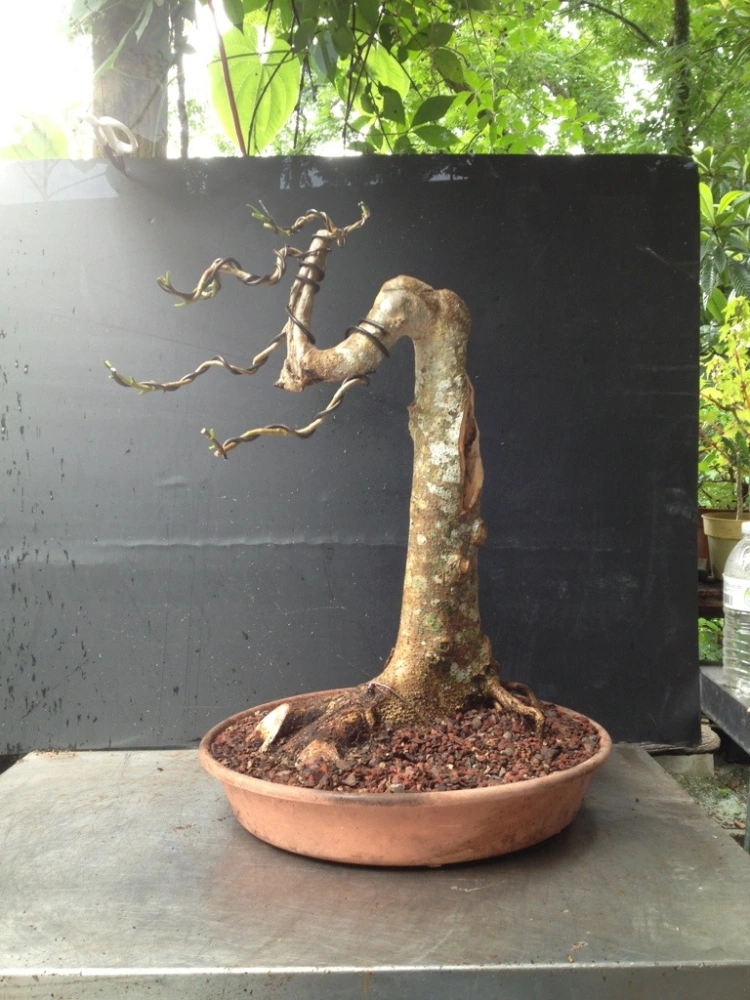
Hmmmmnnnnn
Something’s not right


How’s this?
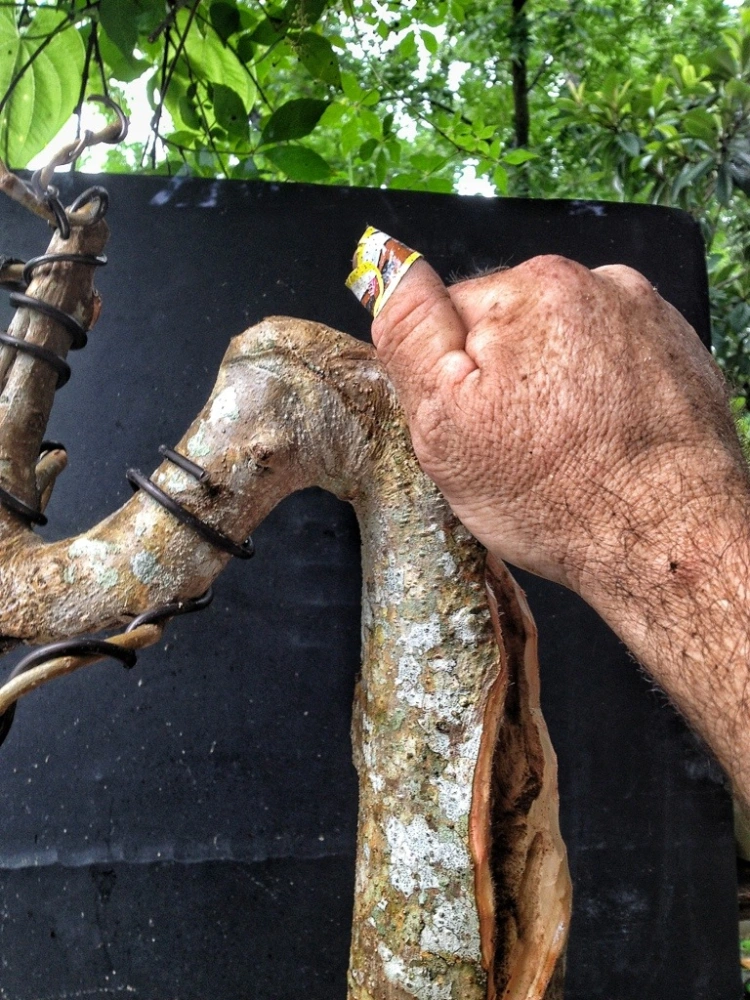
Yeah! (And,yes, that is a SpongeBob Bandaid)
Get out the knife and

Aftercare for these two trees.
Full sun, water, and watch the wires.
In my conversations with Erik (these are my first strangler figs btw) he says that f. aurea’s leaves will reduce. The problem is ramification.
F. natalensis has been used often enough in bonsai culture that its suitability as a bonsai subject shouldn’t be in question.
Of course, it is.
It’s usually questioned by those who hate aerial roots though. Or any tropical for that matter. They can’t all be elms and junipers.
These trees should be fun to watch grow.
We shall see what happens.
Alright then, here’s a drawing of the f. natalensis. (I sent a preview of this post to a friend and he insisted on a drawing)

But you (and he) will have to use your imagination (or wait) on this one
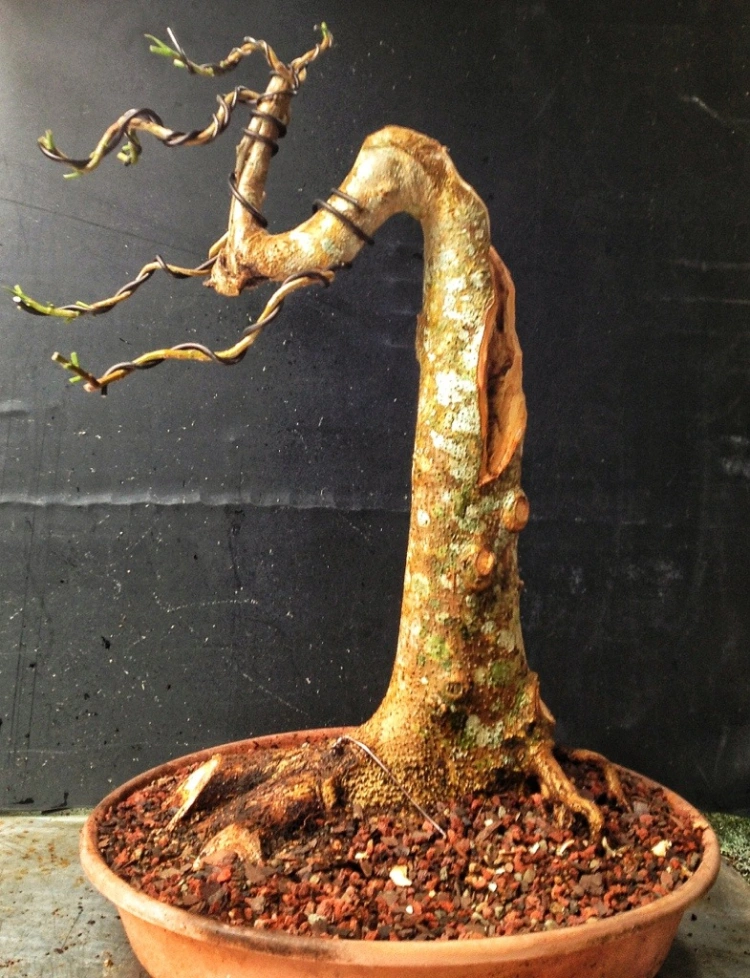
See ya’
I’ve been referring to a few of my Jim Smith trees as ‘natalesis’ which apparently is wrong. Maybe they’re ’89s or something. I have some of the larger-leaved strangler or natalensis or whatever they are. Aggressive aerial roots is an understatement, give them some shade and it looks like spaghetti under there.
LikeLike
I’ll have a look next time I go over or bring them to my place. Could just be microcarpa
LikeLike
May not be microcarpa, but I’ve been known to be wrong. I chose/was attracted to them because they look like larger versions of nerifolia <– whatever the accurate name is. But they're larger than the '89 leaves.
LikeLike
Adam, you come up with some great ideas – creating a wound top side to taper the curve, soften the chop and also to offset an existing old wound on the opposite low side – good post and nice tree. Don’t forget to post the *months later* down the road.
LikeLike
Thanks again
LikeLike
I like the elephant raising its trunk image….giggles
LikeLike
Hi
I am writing from Cape Town, South Africa. I think the information on F.natalensis also being referred to as a “strangler fig” is possilby incorrect.
I have a number of F.natalensis which is indigenous to SA and they are definitely not “stranglers”. They do put out aerial roots but they are normally thin and not very proliferate. The link http://treeco-treeco.blogspot.com/2010/05/ficus-natalensis-natal-fig.html will give some more information.
Locally we refer to F.sur as the “stranger fig” (see http://www.plantzafrica.com/plantefg/ficussur.htm. I use Plantzafrica.com for information on African tree species)
With regard to leaf size both have fairly large leaves in nature but both reduce well with leaf pruning and so make good bonsai specimens.
It does not seem possible to attach images and attachments to this reply so, for those who are interested the I have posted two Strangler fig progressions at https://www.dropbox.com/sh/t3qtmx2kfjl10kw/fQWi28r-dD. These are from an Oyama Bonsai Kai show. for more information see http://www.oyama.co.za
enjoy
Peter Bruyns
I
LikeLike
I began the post with the caveat that there were several unrelated ficus species with the common name “strangler fig” and f. Natalensis was one of them. Another common name is “natal fig”. Most fig species have the capability to germinate above soil and be, in essence, epyphytic. Even f. Microcarpa.
Refer to this book -Trees and Shrubs of Mpumalanga and Kruger National Park
By Ernst Schmidt, Mervyn Lötter, Warren MacCleland page 80.
And I did a web search for “dwarf African strangler fig” and it does yield results for f. Natalensis.
Common names are often inexact and change from region to region as well and that’s why I use the Latin where I can. The two authorities in Florida I consult with are Jim Smith and Erik Wigert.
I would love a specimen for f. Sur to play with and you’ve now piqued my interest.
Thanks for your reply
LikeLike
I can try and collect some ficus sur seeds for you and send you. I have been removing the fruit to date, but never checked if they are pollinated.I collect figs, so I have lots from all over the world. I planted 2cm trees in the ground last year and they are now 20+ cm trunks, if you can believe it. I have chopped them down twice in the past year. Leaves are big but reduce, unattractive similar to ficus sicamorus…rough and the tree is hard to ramify.Ask me on FB if you want to see pictures.
I can try and send you burkei also…much better for bonsai and a strangler. I have some other local figs too but the best and most rare is glumosa. Jerry ID it. Fast growing with tiny leaves smaller that any other fig and for sure smaller than Burt Davii nana.
BTW darling, I dont think your fig is nataliensis…JMHO. Figs can differ from place to place…but yours does not look like natal fig.
LikeLike
Forgot to tell You natal fig has gray bark, and elongated leaves…also it gets this typical tiny barely seen white dots on the leaf always in the same pattern.
LikeLike
Adam, I know this post is old. Did you ever post an update? I was recently down in south Florida and found a F. aurea and I’m hoping to keep it as a bonsai.
LikeLike
I don’t think I did. Both trees have been sold, the literati to a local guy and the more conventional one is up in Jacksonville
LikeLike